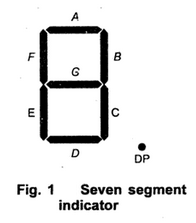Seven Segment Display
A display consisting of seven LEDs arranged in seven segments is called seven segment display. It is shown in the Fig. 1. The seven LEDs area arranged in a rectangular fashion and are labeled A through G. Each LED is called a segment because it forms a part of the digit being displayed. An additional LED is used for the indication of a decimal point (DP).
By forward biasing different LEDs we can display the digits 0 through 9. For example, to display a zero, the LEDs A, B, C, D, E and F are forward biased. To light up a 5, we need to forward bias segments A, F, G, C, D. This in a seven segment display depending upon the digit to be displayed, the particular set of LEDs is forward biased. The various digits from 0 to 9 which can be displayed using seven segment displayed are shown in the Fig. 2.
A seven segment display can also display the capital letters A, C, E and F and also small letters b and d. microprocessor kits often use such seven segment displays.
1. Types of Seven Segment Displays
The two types of seven segment displays area available called,
1) Common anode type 2) Common cathode type
Common anode type
In this type, all anodes of LEDs are connected together and common point is connected to + Vcc which is positive supply voltage. A current limiting resistor is required to be connected between each LED and ground. The connection is shown in the Fig. 3.
Common cathode type
In this type, all cathodes of LEDs are connected together and common point is connected to the ground. A current limiting resistor is connected between each LED and the supply + Vcc. The anodes of the respective segments are to be connected to + Vcc for the required operation of LEDs. The connection of common cathode type display is shown in the Fig. 4.
2. LED Driver Circuit
The output of a digital circuit is logical '0' or '1'. The '0' means low while '1' means high. In the high state the output voltage is nearly 5 V while in low state, it is almost 0 V. If LED is to be driven by such digital circuit, it can be connected as shown in the Fig. 5. When output of digital circuit is high, both ends of LED are at 5 V and it can not be forward biased hence will not give light. While when output of digital circuit is low, then high current will flow through LED as it becomes forward biased, and it will give light.
In practice seven segment displays are used at the output of digital integrated circuits, the output of which is in binary coded decimal form (BCD). Such output has only four lines and it cannot drive seven segments of the displays directly. In such a case a driver circuit is used which is a BCD to 7 segment decoder. It converts 4 BCD lines into 7lines. A typical LED seven segment display with its driver circuit is shown in the Fig. 6. The common anode type display is used.
Notice that, an additional LED corresponding to the decimal point is also provided in the seven segment display, which again has a current limiting series resistance. Hence a positive voltage is applied to the common anode. Therefore selected LEDs are illuminated by making their respective cathodes low (0 V).
Seven Segment Display
 Reviewed by haru
on
February 21, 2018
Rating:
Reviewed by haru
on
February 21, 2018
Rating:
 Reviewed by haru
on
February 21, 2018
Rating:
Reviewed by haru
on
February 21, 2018
Rating:














No comments